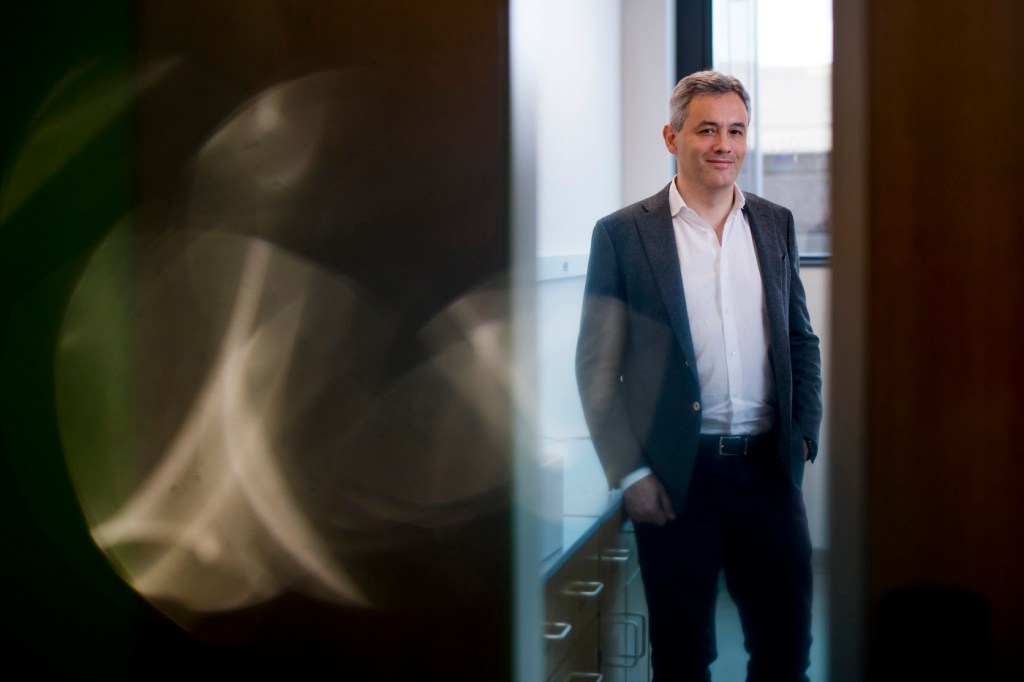How 5G coverage helps the 2022 Winter Olympics get viewer gold

As the Olympic torch crackles to life later this week, signaling the start of the 2022 Olympic Winter Games in Beijing, broadcasters will be leaning heavily on wireless 5G service to ensure fans around the world can watch every ski jump and ice skating triple axel in crisp, seamless detail.
Tommaso Melodia, the William Lincoln Smith Chair Professor of Electrical and Computer Engineering at Northeastern, breaks down exactly how 5G technology works and why the expanded wireless network is vital in an age where viewers expect reliable access to streaming games and entertainment on the go.
Melodia, who also directs Northeastern’s Institute for the Wireless Internet of Things, shares insights into his own work to expand wireless coverage, and discusses how 6G service could go beyond faster, dependable service to transform our physical world. His comments were edited for brevity and clarity.
I have to start out by asking, will you be watching the Olympics, and if so, which sports?
I’m more of a Summer Olympics person, but I’ll try to watch some alpine skiing. Growing up in Italy I was a big fan of Alberto Tomba, the all-time world champion and Olympic medalist in the late ’80s and early ’90s. I’ll probably watch some ice hockey as well.
Can you explain the baseline global network use that we might experience on an average day of wireless service?
Global network usage is complex and varies at different times of the day and in different locations, but in general, cellular networks are providing service by territory. Each territory is divided into cells, and there is a base station at the center. The base station is something similar to your Wi-Fi access point at home, only more sophisticated. It provides connectivity to various users with smartphones in each cell, and if the density of users in a certain area increases, the capacity that is available to each user decreases. It’s like all users are sharing the same pie, which is the capacity of the cell.
Cellular operators, when they deploy their networks, they dimension the cells—which means they determine how big is each cell and how many channels are assigned to each cell—in order to make sure that the usage load is acceptable.
What kind of stress does an event like the Olympics put on a wireless network, where everyone is using the system at the same time?
What happens, if the metric is not dimensioned correctly, is that the number of users grows to the point where the capacity becomes so small that the network starts collapsing. That’s what’s happening when you can’t get any cellular connectivity, when everybody is trying to call somebody else at the same time. The Olympics would cause a significant amount of stress even in normal times, but these aren’t normal times.
There won’t be the same level of in-person viewership on site at the event, so the stress on the 5G network won’t be as big as what you would see in a normal event with millions of people. Still, there’s a lot of emphasis on providing 5G connectivity.
How are television networks preparing for secure, uninterrupted coverage?
Wireless network providers are used to providing services at high-demand locations like stadiums, but the Olympics are completely different because you don’t have the same level of planning and there’s a lot more uncertainty.
The cellular provider in China is taking this pretty seriously, and they want to ensure that they’re going to be able to provide the best possible uninterrupted, secure coverage.
They’ve created a lot of base stations and they’ve put up to 4,000 staffers on site, basically putting two people at each base station who are ready to intervene if something goes wrong. They’ve put equipment in place that’s basically a combination of Wi-Fi routers and 5G equipment that can be quickly deployed if something goes wrong.
What’s your vision of the future of the Olympics, beyond 5G?
Well, I guess after 5G comes 6G. The 5G rollout has been going on the past couple of years, and while it may feel like it’s too soon to think about 6G, the rollout will probably start to happen in 2028. Researchers are very active working on 6G, and here at Northeastern we’ve been organizing an event called the 6G Symposium. It will be the first forum in North America looking at the evolution of the cellular network toward the next generation.
I think that it will enable a much closer interaction between the physical world where we live and operate, and the digital world where all of our data resides. It will enable creating realistic models in the digital world, things like digital twins that are models of real entities that you can interact with in the digital world. It will improve virtual reality and augmented reality, which isn’t just about video games, it’s about creating a really immersive experience in virtual environments.
So perhaps you’ll be able to follow your favorite alpine skier and get an immersive 3D experience where you’re basically skiing with the athlete. There will be a lot of new capabilities to address society’s needs.
For media inquiries, please contact media@northeastern.edu.




